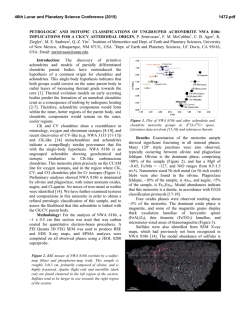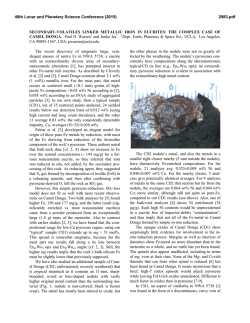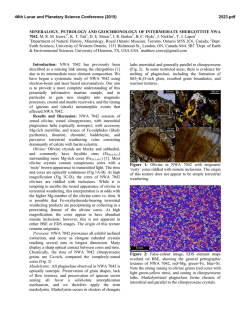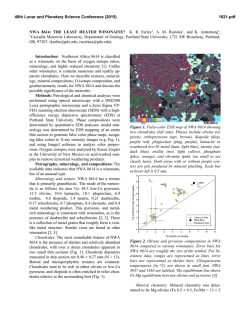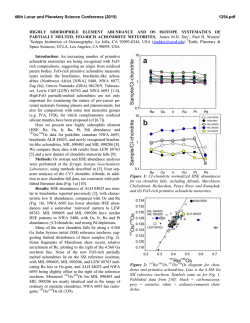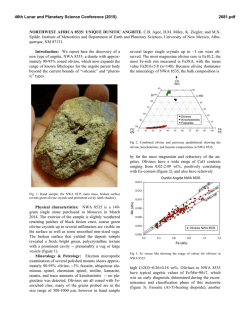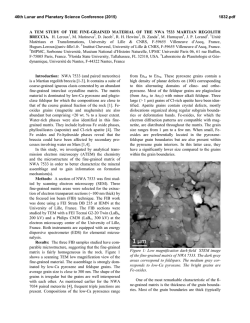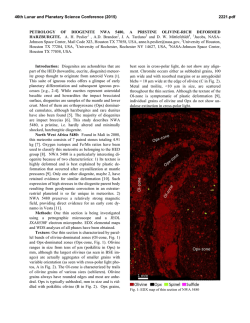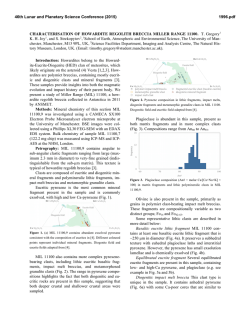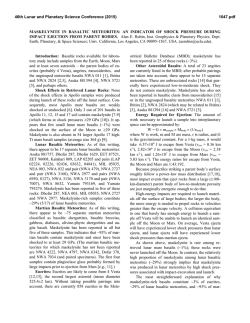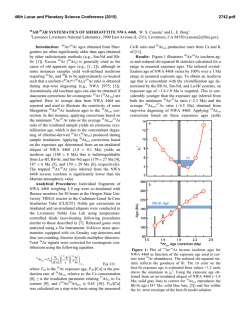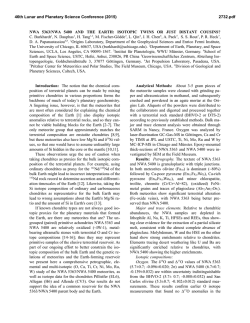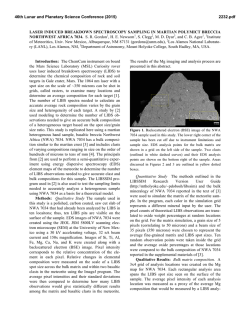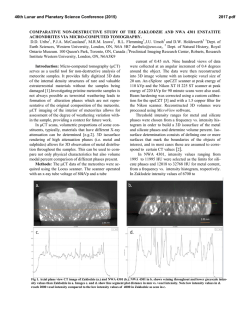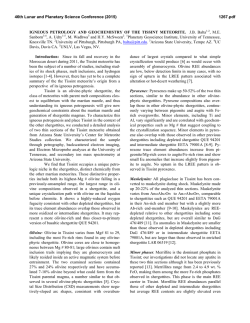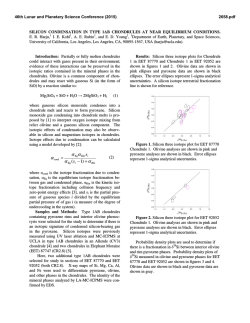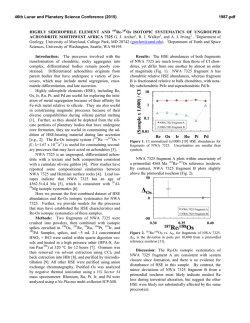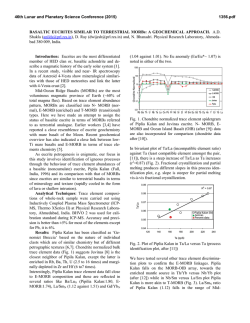
2570
46th Lunar and Planetary Science Conference (2015) 2570.pdf PETROLOGY OF UNGROUPED AND ANOMALOUS ACHONDRITES SAU 493, NWA 4470, NWA 6962, AND NWA 5297. D. R. Dunlap1, Y-J. Ku2, L.A.J. Garvie1, and M. Wadhwa1 1 Center for Meteorite Studies, School of Earth and Space Exploration, Arizona State University, Tempe, AZ 85287 ([email protected]), 2Department of Geosciences, National Taiwan University, Taipei City 106, Taiwan (R.O.C) Introduction: Achondrite meteorites provide a record of the earliest planetesimal accretion and differentiation in the Solar System ([1] and references therein). As such, detailed investigations of these meteorites are key to understanding planet formation processes. In recent years, many new and unusual types of achondritic meteorites have been discovered (primarily from meteorite collection efforts in the cold and hot desert regions of the world) that do not belong to the commonly accepted achondrite classes such as the Howardite-Eucrite-Diogenite group (HEDs) or primitive achondrites such as brachinites. We have recently begun an investigation of the petrology, geochemistry and chronology of several of these achondrites that have been classified as “ungrouped” or “anomalous”. The main goal of this project is to gain a more comprehensive understanding of the time scales and processes involved in the accretion and differentiation of the diverse parent bodies of these unusual achondrites. More specifically, this study focuses on petrographic studies of four such samples, Sayh al Uhaymir (SaU) 493, Northwest Africa (NWA) 4470, NWA 6962 and NWA 5297. Samples Descriptions and Methods: Sayh al Uhaymir 493 is a single 134 g stone from Oman. It has a medium-grained (200 to 500 µm) hypidiomorphic cumulate igneous texture. Pyroxene and plagioclase are the dominant phases. Chromite, ilmenite, Tibearing hematite, and kamacite occur as accessory phases. SaU 493 has been previously described as an anomalous eucrite based on evidence of Fe3+ in the pyroxenes, the presence of hematite, and the apparent lack of a metal [2,3]. NWA 4470 occurs as 48 fragments totaling 631g. This meteorite is classified as an anomalous eucrite [4]. It has a brecciated texture dominated by zoned pyroxene and plagioclase. Pyroxene zonation is gradational from core to rim. Olivine is found mantling pyroxene grains. Accessory phases include troilite, silica, and zircon found in association with ilmenite and Caphosphate. NWA 6962 is a single 59.8 g stone. It is classified as a brachinite-like ungrouped achondrite [5]. The sample has a cumulate igneous texture dominated by equigranular (~750 µm) olivine. Small melt inclusions with sodic plagioclase composition are common within the olivine. Pyroxene and plagioclase occur intersititally between olivine grains. Accessory phases include Ni-free kamacite, merillite, found in association with pyroxene, and Ti-poor, Al-bearing chromite grains (to 800 µm). NWA 5297 is a single 130 g. This sample is classified as an ungrouped primitive achondrite [6]. It has a poikiloblastic metamorphosed texture dominated by olivine, along with low-Ca pyroxene and plagioclase. Taenite and Ni-bearing troilite occur as accessory phases. Polished sections of each of these meteorites (i.e., SaU 493, NWA 4470, NWA 6962, and NWA 5297) were obtained from the Center for Meteorite Studies collection at Arizona State University (ASU). The sections were analyzed with a Cameca SX-100 electron probe at the University of Arizona. Major phases were measured quantitatively using wavelength dispersive spectroscopy (WDS), with identification and characterization of minor and accessory phases made qualitatively using energy dispersive spectroscopy (EDS). Results: SaU 493. This sample is dominated by pyroxene grains with exsolution lamellae of varying thickness. The host pyroxenes are Fs-rich (average composition Fs57.1Wo3.5), with the exsolved phase being Ca-rich augite (average composition En31.0Fs28.7Wo40.5). The plagioclase is predominantly subhedral and Ca-rich with a range of compositions (An87.4-91.9Ab7.7-12.1). NWA 4470. The dominant mineralogy consists of low-Ca pyroxene, high-Ca plagioclase, and Fe-rich olivine. The olivine is predominantly found along pyroxene grain boundaries, and has Fa80.3±0.3 composition. The pyroxenes show distinct zonation from core to rim, from (Wo4.5-6.3Fs29.6-38.8, Mg# = 0.65) to (Wo1.75.4Fs53.5-61.1, Mg# = 0.41). NWA 6962. Olivine is dominant with a uniform composition of Fa45..9±0.3. Melt inclusions (to ~50 µm) are common in some olivines and have a sodic plagioclase composition of Ab95.4Or4.5. The interstitial plagioclase is also Na-rich, with an oligoclase composition (averaging An24.4Ab74.8Or0.5). The pyroxenes occur as augite and have a range in composition of (Wo44.448.1Fs12.3-22.2, Mg# = 0.59-0.76) NWA 5297. This sample has a complex poikiloblastic recrystallized texture dominated by irregular olivines, with sparse patchy anhedral pyroxene. The pyroxene (Wo3.6Fs24.1) and olivine (Fa29.5 ±0.3) show a limited range of compositions. The albitic plagioclase shows slight variation in composition of (An8.6- 46th Lunar and Planetary Science Conference (2015) 17.4Ab79.6-85.8Or2.9-6.4). Accessory minerals include taenite (average ~32 wt% Ni), chromite, troilite with variable Ni contents, and merrilite. Disscussion: The samples discussed above have chemical and textural characteristics that are, in many cases, comparable to more commonly recognized achondrite groups. However, each of these samples also have some distinctive characteristics that imply that they originated on parent bodies that are not sampled by the common types of achondrites. SaU 493: A previous study identified several features, including lack of olivine or metal, pyroxenes with Fe3+, and the possible presence of indigenous hematite, which precluded classification as a eucrite [2,3]. If primary, these features indicate formation processes unlike any known on the eucrite parent body (EPB, thought to be the asteroid 4 Vesta) [7,8]. In our study, no olivine was found but kamacite metal was found to occur. Moreover, hematite was also found, but only in association with vein networks (possibly suggesting an origin during terrestrial weathering), but this finding needs to be more rigorously assessed. If the hematite is of primary occurrence, it would suggest a post-magmatic, oxidizing high-temperature event on the SaU 493 parent body. This would imply that SaU 493 represents a new group of eucrite-like achondrites that originated on a parent body distinct from the EPB. Alternatively, if the hematite is of weathering origin, SaU 493 may have originated on the EPB (as also suggested by its oxygen isotope composition [2]). NWA 4470: This sample has been previously classified as an anomalous eucrite [4]. However, our data suggests that NWA 4470 is likely to be a brecciated basaltic eucrite. Similar core-to-rim compositional zonation of pyroxene has been shown previously in the eucrite Pasamonte [9]. Olivine also occurs in the Pasamonte and NWA 049 eucrites, and similar to NWA 4470, occurs along pyroxene grain boundaries and is thought to form during high temperature metasomatism [9]. Given these findings, as well as the presence of the accessory phases, all of which are common among eucrites [10], we believe NWA 4470 to be monomict brecciated basaltic eucrite. Further oxygen isotopic and trace element investigations will be necessary to confirm this. NWA 6962: This sample closely resembles the brachinites in terms of olivine modal abundance and accessory phases. However, geochemical data show the olivines in NWA 6962 are enriched in Fe (Fo53) compared to typical brachinites (Fo65-70) [11]. The interstitial augite has higher Fe contents and lower Mg# of 0.68 compared to augites in typical brachinites (Mg# = 0.79-0.82) [11]. The Fe/Mg ratios in the NWA 6962 silicates plot well outside the range of silicates in 2570.pdf other primitive achondrites [12] and this may be indicative of higher degress of thermal processing. NWA 6962 has an oxygen isotope composition that is distinct from brachinites and plots just within the field of the ureilites [3,13]. In light of this evidence, NWA 6962 does appear to be a unique ungrouped achondrite that may have originated on a parent body not sampled by other known achondrites. In particular, a genetic relationship to the brachinites [3] seems unlikely given the results presented here. NWA 5297: This metamorphosed primitive achondrite has homogeneous olivine compositions (Fa30), similar to brachinites [11]. Plagioclase is Na-rich and similar in composition to GRA 06128/06129 ungrouped achondrites, with pyroxene compositions within the range of other primitive achondrites [14]. The silicates of NWA 5297 plot within the field of brachinites and primitive achondrites on a plot of Fe/Mn versus Fe/Mg ratios [12]. The oxygen isotopic compositions overlap with the LL chondrites [6,13]. Given these findings, a clear connection cannot be made between NWA 5297 and any known primitive achondrite group. It seems likely to have sampled a parent body that may have had LL chondrite-like geochemical and isotopics characteristics, and which underwent incipient thermal processing. Finally, as part of our ongoing comprehensive investigations of these achondrites, we have initiated chronological studies of several of the samples discussed here to better understand the timing of melting and differentiation events on their parent bodies. References: [1] Mittlefehldt D. W. et al. (1998) Rev. in Min. & Geochem., 36, 4.1-4.195 [2] Irving A. J. et al. (2011) LPSC XLII, Abstract #1614. [3] Meteoritical Bulletin (2012) MAPS, 47, E1-E52. [4] Meteoritical Bulletin (2007) MAPS, 42, 1647-1694. [5] Meteoritical Bulletin (2013) MAPS, 47, (in press) [6] Meteoritical Bulletin (2010) MAPS, 45, 1530-1551. [7] Binzel R. P. and Xu S. (1993) Science, 260, 186-191. [8] McSween et al. (2013) MAPS, 48, 2090-2104. [9] Barrat J. A. et al. (2011) GCA, 75, 3839-3852. [10] Mittlefehldt D. W. (2014) Chemie der Erde (IP). [11] Keil K. (2014) Chemie der Erde, 74, 311-329. [12] Goodrich C. A. and Delaney J. S., (2000) GCA, 64, 149-160. [13] Clayton R. N. and Mayeda T. K. (1999) GCA, 63, 2089-2017. [14] Day J. M. D. et al. (2012) GCA, 81, 94-128.
© Copyright 2025

